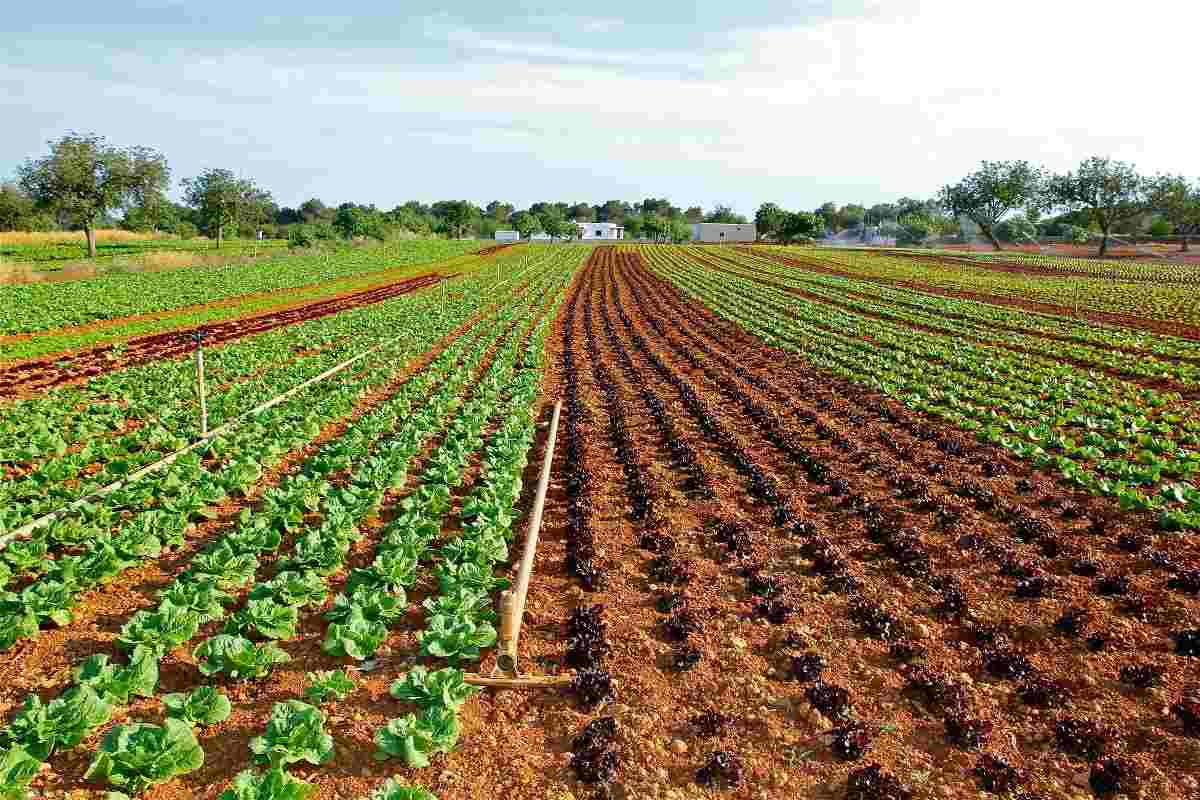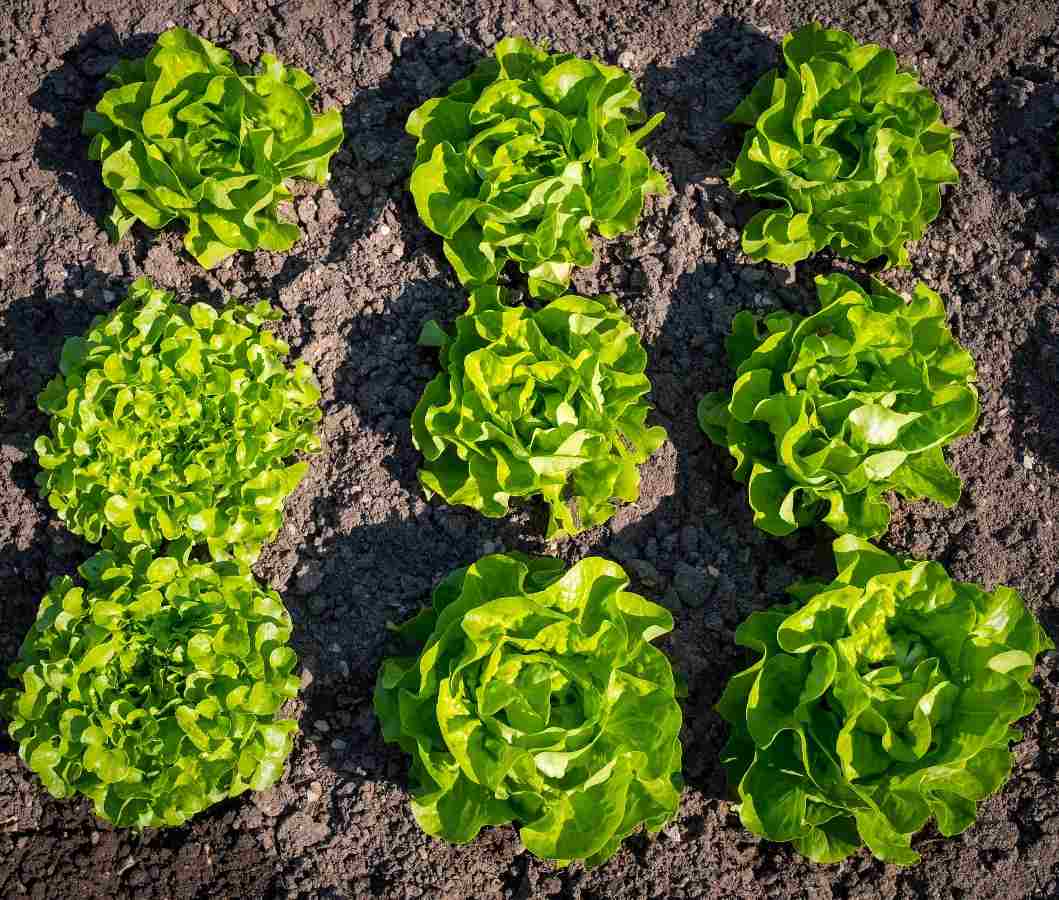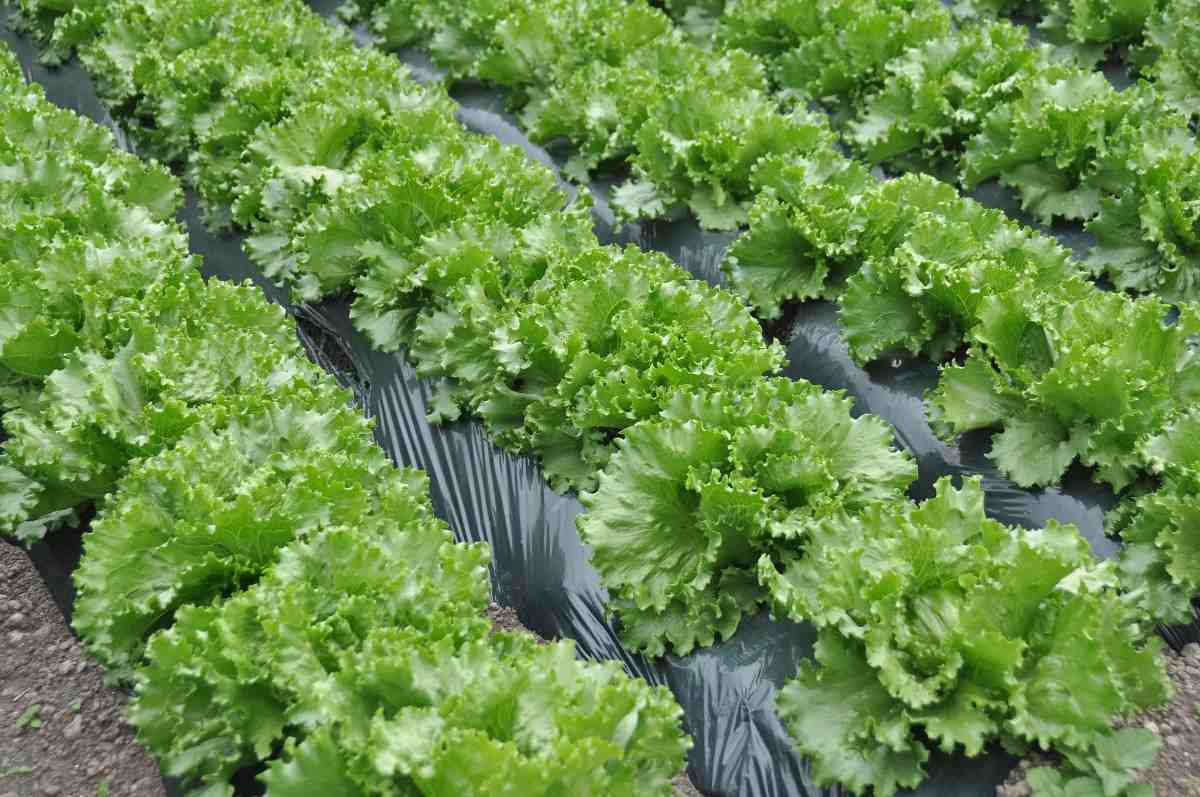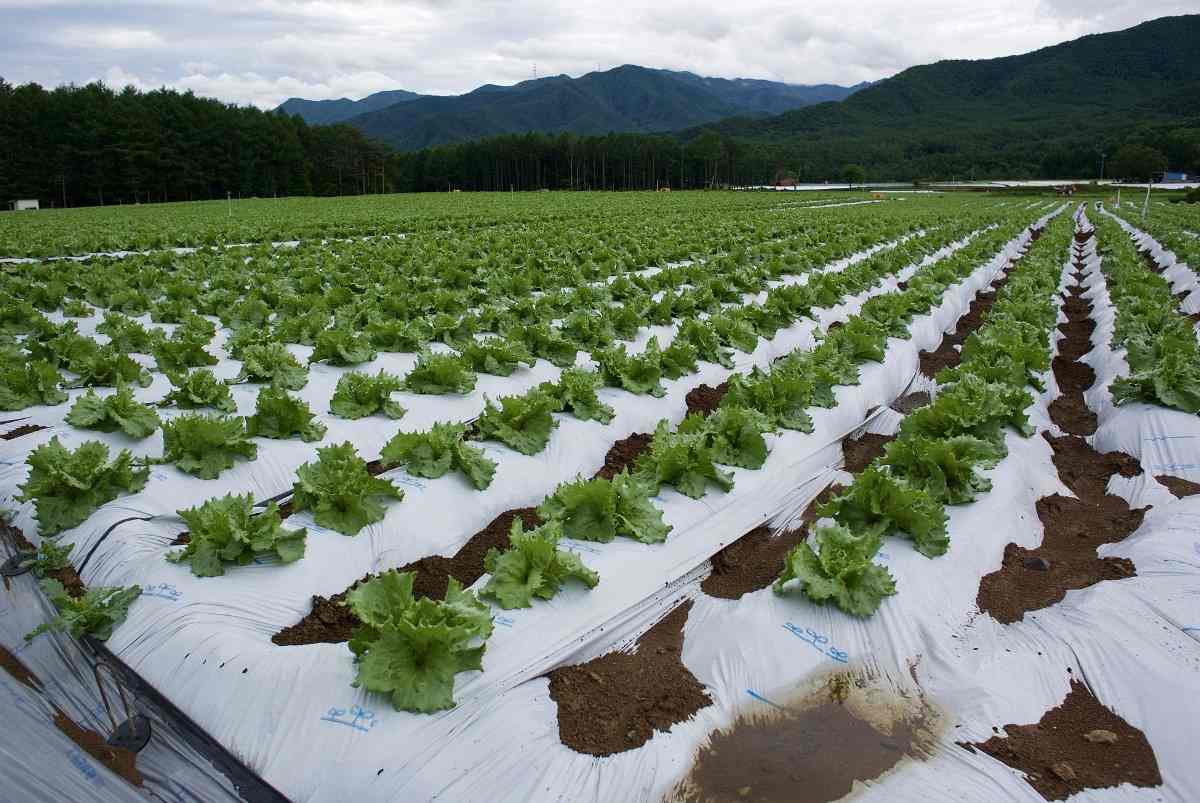Introduction to organic Lettuce farming
Lettuce belongs to the Asteraceae family. Organic Lettuce is a self-pollinating annual. Lettuce is indeterminate and it will flower for up to 2 months. Organic Lettuce is a leafy vegetable consumed all over the world.
A step by step guide to organic Lettuce farming
If you are planning to grow lettuce without chemicals and synthetics, you are in the right place, let us encourage organic food farming for a better future. In this article, we will discuss how to grow organic lettuce and lettuce crop care, etc,.

Soil requirement for organic Lettuce farming
Lettuce will require partial shade in warm climates, sandy soil, plus rich and regular water. Work the soil carefully before planting. If planting Lettuce seeds, rake the surface smooth. Transplants can tolerate a rougher planting bed. Dig in plenty of garden compost and soil alterations rich in nitrogen to promote good leaf development.
Organic Lettuce is easy to grow in most conditions, so long as you do not allow the young plants to get too hot. Try to give your Lettuce about 6 hours of sun a day; any more and they might go to seed prematurely. Organically rich, loose garden soil is important for growing healthy Lettuce heads. Must and should keep your garden beds full of organic compost that is easy to access for the shallow roots of your Lettuce plants.
Lettuce plant spacing
An organically grown leaf Lettuce variety is direct-seeded using a four-bed precision planter, planting 2-rows on 40-inch beds. Fields are planted to a stand of 156,000 plants per acre at 2 to 3-inch plant spacing. Organic Lettuce is planted from late December to mid-August. The plants are hand thinned nearly 30 days after planting.
Planting soil preparation and field preparation for Lettuce seed must follow the same methods as for Lettuce head production. The soil should be loosened to a depth of around 12 inches, using a tiller, spader. A fine, uniform seedbed should be prepared. If flood irrigation will be regularly used, seedbeds must be well elevated to encourage drainage. Based on the variety and type, organic Lettuce seed can need a long growing season. Due to this, planting is done as early in the spring as practical. Lettuce seed needs 1.7°C for germination and will be inhibited by temperatures above 33°C. Organic Lettuce for seed production can be either transplanted or direct-seeded. As in standard Lettuce production, transplanting allows a longer growing season and additional pre-planting cultivation. In seed production, transplanting also provides an additional opportunity to rogue off-types before putting the transplants in the field.

Conditions for organic Lettuce farming
Organic Lettuce has roots which are shallow and easy to disturb. Because of this, all cultivation should be done gently and shallowly. Initial weed pressure can be decreased by flushing weeds and cultivating before transplanting or planting. Mechanical cultivation can be done soon after planting because the plants are still small. Cultivation must be between 1.5 to 4inches deep. If additional weed control is essential later in the season, it can be done by hand. Because organic Lettuce has a shallow root system, available water needs to be present close to the soil surface. This is accomplished by regular watering, commonly applied through overhead sprinklers during the vegetative stages of growth.
Once the Lettuce is flowering, water should not be applied to the canopy, because free moisture on the leaves and flowers can decrease pollination and increase the risk of disease. Many organic growers are now using drip irrigation systems to good effect but some still rely on overhead irrigation during the early stages of growth to start a large, vigorous frame on their plants to ensure good seed yields, before switching to drip for the reproductive stage of the crop’s growth.
Planting organic Lettuce

Step 1) Lettuce can be transplanted or direct-seeded to the field or high tunnel ground bed. In general, plants that are harvested as heads are transplanted while those harvested as individual leaves are seeded. In the field, the pelleted seed is usually used for direct seeding with a simple push-type seeder or a vacuum seeder. Transplants are normally set by hand or with a waterwheel setter onto raised beds with plastic mulch.
Step 2) Organic Lettuce can be seeded or transplanted every 3 to 6 weeks for a continuous harvest. All transplants and seeds used in organic production must be certified organic and either purchased from a reputable dealer or produced organically on the farm.
Step 3) Individual organic certifiers may permit the use of untreated conventional seed if suitable organic seed is unavailable; though, the grower must first conduct a reasonable search for certified organic seed. This means documenting the attempt to find the certified organic seed of the specified variety from a minimum of 3 sources. Neither transplants nor seed can be treated with any prohibited substances, such as synthetic fungicides.
Step 4) Greens and Lettuce are seeded into cell plug trays in the greenhouse 4 to 6 weeks before being transplanted. Fertilizers and potting soils used in transplant production must be organically approved.
Step 5) Transplanting has the advantage of resulting in an earlier crop than direct seeding, as well as a more accurate plant spacing and final plant population. Moreover, transplants are less exposed to insect damage, drought, or other early-season stresses, and faceless competition from weeds.
Fertility management for organic Lettuce farming
The best approach to fertility management for an organic grower is to select a field with balanced fertility, good tilth, and adequate organic matter. Sufficient phosphorus is important for early plant development and to produce good flowering and reproductive structure. Nitrogen must be adequate to promote plant growth and establish a good vegetative “frame”, but not excessive to avoid weak plants. If fertilizer is necessary then a 3:2:2 formula must supply adequate nutrition. Because Lettuce has relatively shallow roots, nutrients should be available in the top 12inchs of soil. Soil pH should between 6 and 6.5 to promote calcium availability.
Organic matter can be incorporated into the soil through the application of compost, animal manures, or cover crops. Usually, there are no restrictions regarding the source of animal manure in organic production systems; that is, it can come from conventional farming operations. Soil fertility can also be enhanced by incorporating leguminous cover crops and using approved natural fertilizers. Supplemental organic nutrient sources contain fishmeal, blood meal, cottonseed meal, and soybean meal.
In case if you miss this: Organic Guava Cultivation, Farming Practices.

The use of organic fertilizers has increased due to the beneficial effects that organic matter provides to intensively and conventionally cultivate the soil. Though, the source and ideal dose of organic fertilizer for Lettuce cultivation is not yet a consensus in the literature, since the doses can vary according to the soil, climate, and cultivar conditions used.
Organic mulching for Lettuce farming
Organic Lettuces benefit from a good layer of mulch. Install a 2 to 3 inches layer of organic mulch, such as straw, wood chips, leaves, or grass clippings around the Lettuce, be sure to leave a little space around the plant to prevent rot. This layer of mulch will help to hold moisture, maintain the soil cool, reduce the amount of weeding you have to do, and keep the Lettuce clean by preventing soil from splashing up on the leaves when you water.
Organic pest and disease management in Lettuce farming
Pest management in organic Lettuce emphasizes prevention through good production and cultural methods. The goal is not to complete the elimination of pest problems, but rather to manage insects and diseases to keep crop damage within adequate economic levels. Effective and economically efficient pest management in organic Lettuce farming needs multiple strategies and an integrated systems approach. Monitoring pests through regular crop inspections and accurate identification are essential to keeping ahead of potential problems.
Lettuce plants are susceptible to several foliar diseases that can decrease the quality and marketability of leaves. These include powdery mildew, downy mildew, and various fungal leaf spots. Young, tender plants are susceptible to damping-off, while older plants may succumb to Rhizoctonia bottom rot and Sclerotinia drop. Many Lettuces are susceptible to bolting during persistently hot weather and long days; though, some heat-tolerant cultivars are available. Tip burn, an abiotic disorder generally related to nutritional problems, can also affect greens and Lettuce.
Disease management strategies include maintaining well-balanced fertility, growing disease-resistant cultivars, practicing sanitation, managing soil moisture, and using optimum planting densities. Potential insect problems include cutworms, aphids, wireworms, flea beetles, leaf miners, and leafhoppers. Aphids and whiteflies can be mainly problematic in high tunnel environments. Insect management strategies contain handpicking, applying organically approved insecticides, and using physical barriers.
Downey mildew can cause crop loss and damage to organic Lettuce production. Organically suitable copper products are a possible means of disease management; though, the application will not provide control under severe pressure but may provide limited control under low to moderate pressure. Resistant varieties are the best control plan for downy mildew in Lettuce.
Organic pest control tips for Lettuce
Here are a few things to look for and tips on controlling insect pests of Lettuce;
Aphids – Aphids pose a quadruple threat. First, they suck the water and nutrients from the plant tissue, resulting in the curling of leaves and the demise of young plants. Secondly, they are often parasitized and the dead aphids don’t rinse off the leaves. Third, aphids act as virus vectors often assisting in the introduction of diseases like Lettuce mosaic. Finally, aphids deposit significant amounts of honeydew on the leaves, which foster the growth of sooty mold.
One method for controlling aphids is to encourage or introduce natural predators such as lady beetles, damsel bugs, lacewings, flower fly maggots, parasitic wasps, and birds. Neem oil or horticultural soap may also be used to control the aphid population. There are no systemic insecticides to control aphids.
Caterpillars – Caterpillars are the larval stage of some species of moth or butterfly and can be particularly destructive. Butterflies and Moths prefer to lay their eggs close to food sources.so, the caterpillars don’t have to travel far to find food when they hatch.
Natural Caterpillar Pest Control;
- Pick caterpillars off leaves and place them somewhere they will not be a nuisance, crush them, or throw them in a bucket of soapy water.
- Spray affected plants weekly with organic Bt. It is made from naturally occurring bacteria found in the soil. Bt is non-toxic to pets and humans, so only caterpillars will be affected if they come into contact with the sprays.
Thrips – Thrips may affect the entire organic Lettuce plant in all its stages of growth and end up causing leaf malformation. They are also vectors for some organic Lettuce diseases.
Leaf miners – Leaf miners insert eggs in the upper leaf surface, which in turn become maggots. Use of the insecticide Spinosad in commercial farming has seen a reduction in infestation, although, with all things, some evidence now points to their resistance to it.
Beetles – Beetle varieties are soil infecting insects for the most part; their larvae hatch in the soil and often feed on the roots of the Lettuce plants.
Snails and slugs – Snails and slugs adore the tender, young green Lettuce and can voraciously erase any hint of seedlings almost as soon as they are planted. They hide during the daytime hours among weeds, stones, plant debris, boards, ground cover, and anything close to the ground. Hence, it’s important to maintain a clean area surrounding the Lettuce shoots to deter them. Also, utilize drip irrigation to decrease the humidity and moist areas where these critters congregate. Some types of plants such as nasturtiums, fuchsias, begonias, geraniums, lavender, rosemary, and sage are avoided by, so including these plants among or near Lettuce rows should help.
Organic bait, traps, and barrier placement are all useful tools in the removal of slugs and snails. Water the area slightly to encourage the snails and slugs to come out and bait in the afternoon or early evening. If you are not squeamish, a successful method of removal is to hand pluck the insects from habitable areas 2 hours after dark with the aid of a flashlight.
Spider mites – Spider mites are a type of arachnid closely related to ticks and spiders. They are quite small so you will easily identify them by the yellow patches and small webs they leave behind on leaves. Their webbing is very thin and will make the underside of leaves look dusty. Affected leaves will look discolored or bleached.
The leaf discoloration closely resembles nutrient deficiency so be sure to check for mites when you add nutrients and check your water pH value. Spider mites can be tough to get rid of. Test for them by tapping a leaf onto a sheet of white paper. Mites will fall off the leaf onto the paper and will be visible with a magnifying glass.
Natural Spider Mite Pest Control;
- Introduce natural insect predators like ladybugs
- Harvest the problem plant to avoid further exposing your healthy plants.
- Using organic pest management sprays like Neem Oil, Bt, or Spinosad on your remaining plants, coating the leaves evenly 1 to 2 times per week.
When and How to harvest Lettuce.
Organic leaf Lettuce is hand-harvested under contract 70 to 80 days after planting. Cool-season plantings may need 130 days to mature but as the season warms, time to maturity decreases. Harvest organic Lettuce when the outer leaves are about 6 inches long. This ensures that the plant will survive after the leaves are removed. Harvest outer leaves to encourage inner leaves, tender leaves to grow. Lettuce is crispest if picked in the morning. Use a pruning knife to cut heads just below the lower leaves, or pull them out by the roots. Head and romaine types mature about 70 days from seed; leaf types mature in about 40 days.
Leaf Lettuce will regrow if just the leaves are harvested. Water and harvest again a few weeks later. For best flavor, pick in the early morning, rinse and eat fresh, or refrigerate immediately. Store, loosely packed in plastic bags, in the vegetable crisper.
In case if you are interested in this: Growing Organic Potatoes in Backyard.